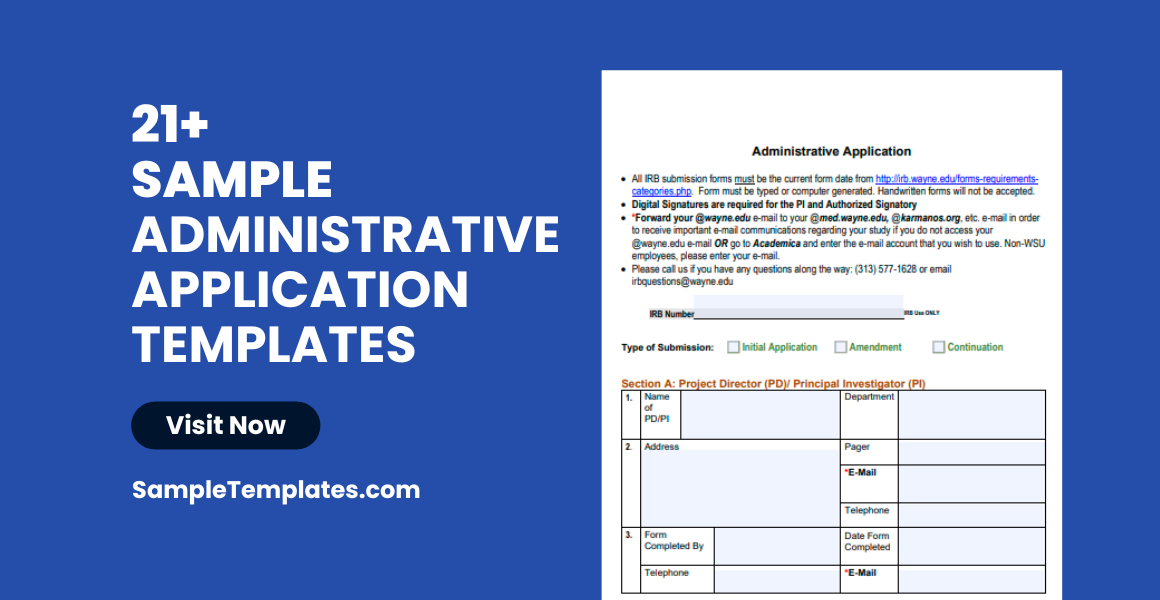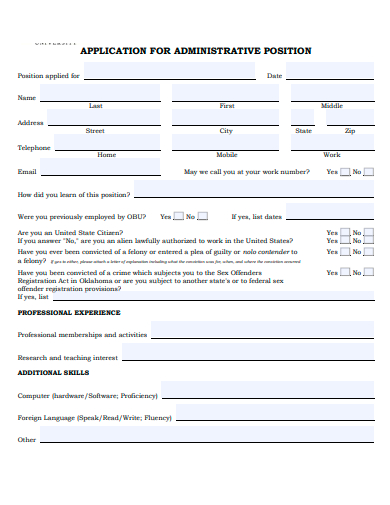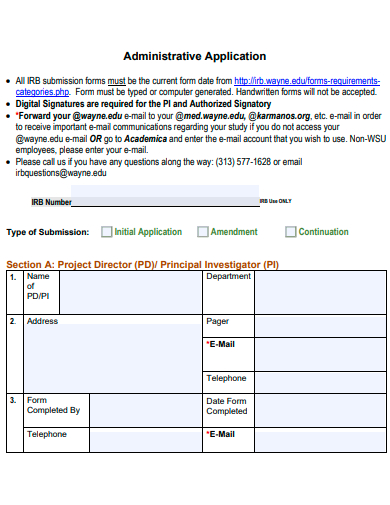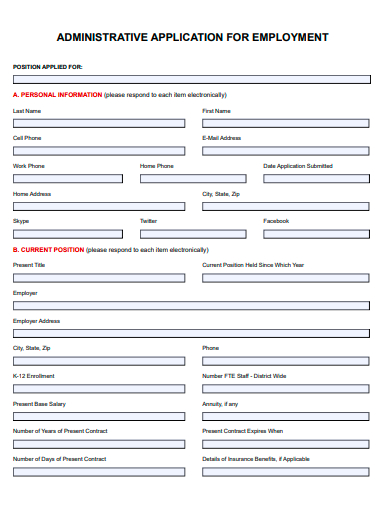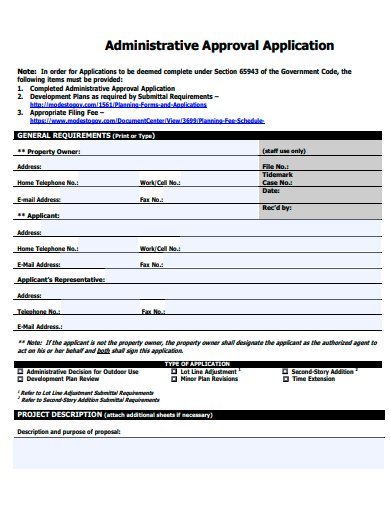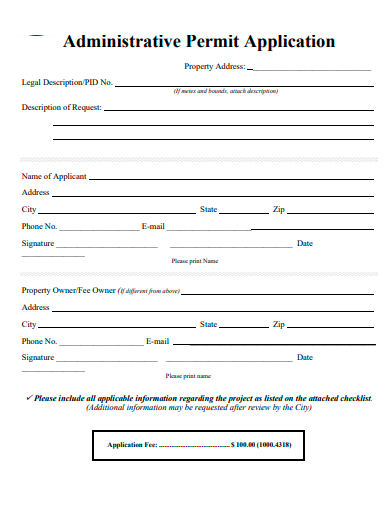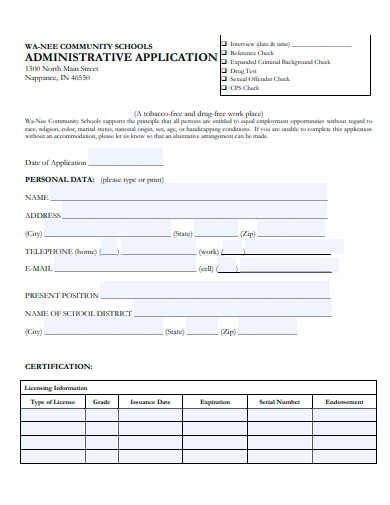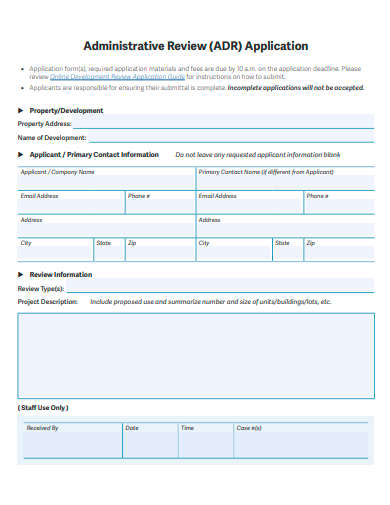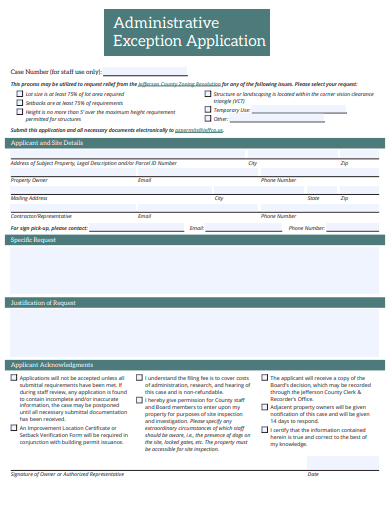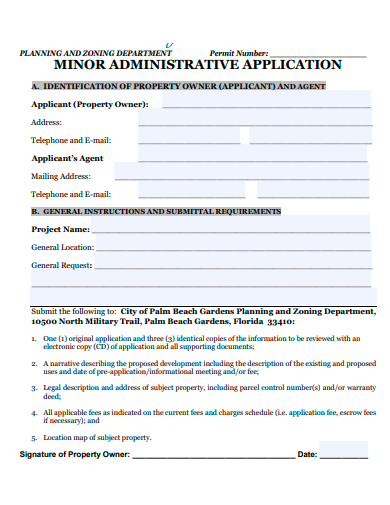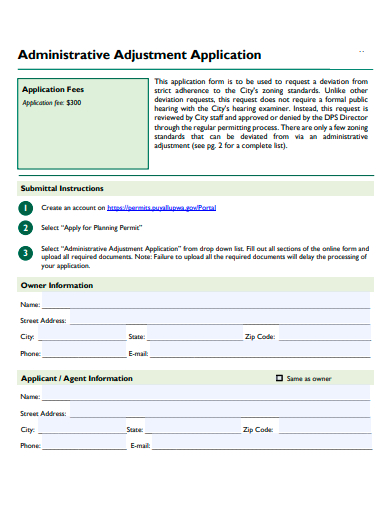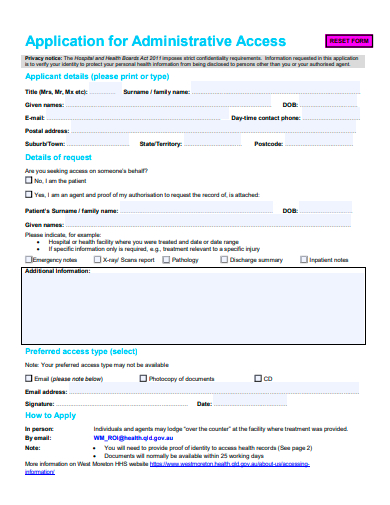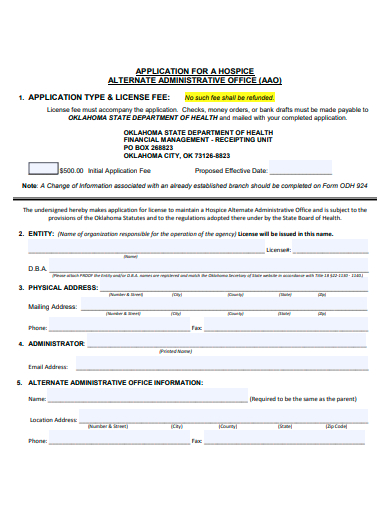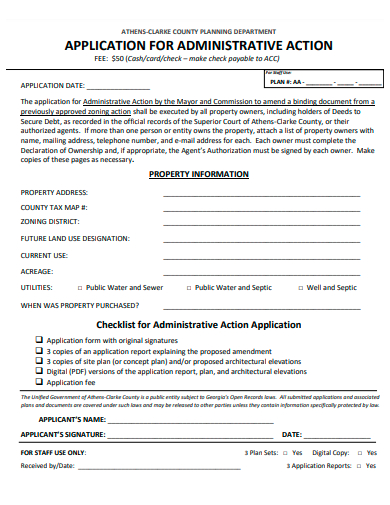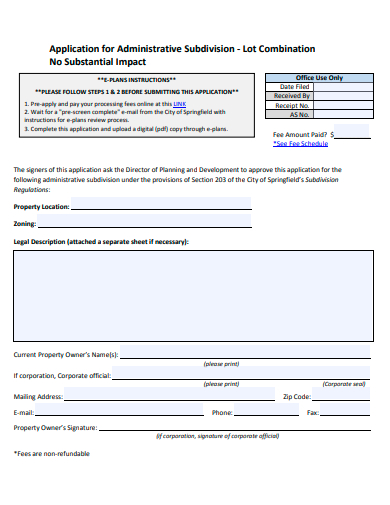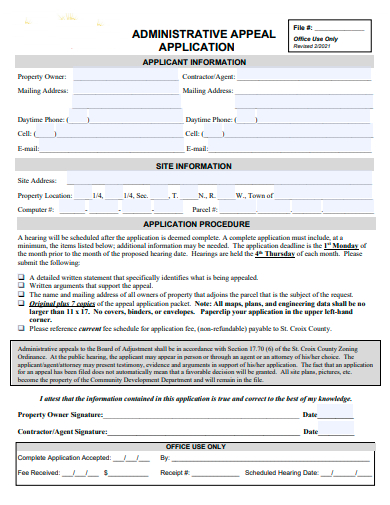In the vast ecosystem of professional organizations, the ‘Administrative Application’ emerges as a keystone. Tailored to sieve the best talents for managerial and operational roles, it ensures the backbone of an entity remains strong and efficient. From streamlining processes to nurturing team dynamics, an adept Administrative Application is the first step in building a robust administrative team. Delve into our guide to decode its significance, structure, and the transformative potential it holds. You can also see more templates like Job Application Writing Samples.
21+ Administrative Application Samples
1. Sample Job Application Letter for Administrative
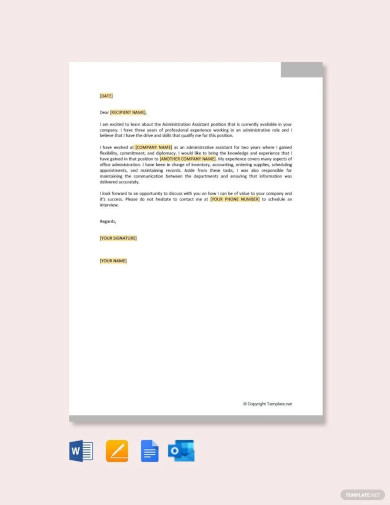
2. Sample Job Application Letter for Administrative Assistant

3. Sample Administrative Position Application Template
4. Sample Administrative Application Template
5. Sample Administrative Certificate of Approval Application Template
What is an Administrative Application?
An Administrative Application, in the context of a digital document, is a formal request or sample petition typically made to a governing body or authority to take a specific administrative action. These can be used in various contexts, from legal and governmental settings to academic and corporate environments.
Key Components of an Administrative Application
1. Applicant Details: This section contains essential details about the person or entity making the request, including their name, address, contact details, and other pertinent identification information.
2. Purpose: A clearly defined sample statement outlining the reason for the application. This segment is crucial, as it provides context to the reviewing authority about why the application is being made.
3. Supporting Documents: Often, the application will need to be accompanied by documents that support the claims or requests made in the application format.
4. Declaration: In many cases, the applicant must provide a statement declaring that the information provided is accurate and truthful.
The Importance of Clarity and Precision
Given that Administrative Applications are formal documents, it’s crucial to be clear, concise, and precise. Ambiguities can lead to delays in processing or even rejection. Therefore, always ensure that the language used is unambiguous, and the intent is evident.
Common Uses of Administrative Applications
1. Legal Proceedings: Individuals might submit an administrative application to a court or tribunal seeking specific reliefs or actions.
2. Government Procedures: These can be used to request certain governmental actions, such as permit approvals, licenses, or other regulatory requirements.
3. Academic Settings: Students or faculty may utilize these applications to request actions like course changes, leaves of absence, or other administrative tasks.
Processing and Review
Once submitted, the reviewing body will process the Administrative Application. This involves checking for completeness, verifying supporting design documents, and assessing the validity of the request. The duration for processing can vary based on the nature of the request and the reviewing body’s protocols.
Primary Purposes of an Administrative Application:
1. Formal Request for Action
One of the primary purposes of an Administrative Application is to formally request a specific action or decision from an authority. This structured format ensures that the request is clear, documented, and traceable.
2. Documentation and Record-Keeping
The application acts as a written record of the request made, the details provided by the applicant, and any supporting evidence or process documentation. This is crucial for transparency and can be referenced in the future if any disputes or clarifications arise.
3. Streamlining Administrative Processes
By standardizing the format in which requests are made, Administrative Applications allow for the efficient processing of these requests. Authorities can easily categorize, prioritize, and handle these applications based on the nature of the request, the urgency, or any other criteria they have set.
4. Providing Necessary Details
The structured format of the application ensures that the applicant provides all the required information for the authority to make an informed decision. This minimizes back-and-forth communication and accelerates the decision-making process.
5. Legal and Regulatory Compliance
In many contexts, submitting a formal Administrative Application is not just a matter of efficiency but a legal or regulatory requirement. It ensures that the applicant adheres to the proper channels and procedures as mandated by law or sample policy.
6. Establishing Accountability
By submitting a formal application, both the requester and the authority establish a chain of accountability. The requester is accountable for the accuracy and truthfulness of the information provided, while the authority is accountable for processing the application fairly and transparently.
7. Facilitating Communication
An Administrative Application serves as a bridge between the public (or entities) and authorities. It provides a platform for the public to voice their needs, concerns, or requests in an organized manner, ensuring that they are heard and acted upon.
Historical Context of Administrative Applications
While the digital age has ushered in electronic formats for most official documents, the roots of administrative applications trace back to handwritten or typed requests. Historically, these applications acted as the primary communication medium between individuals and authoritative bodies, cementing their role in bureaucracy.
Technological Advancements and Their Impact
1. Transition to Digital: The move from sample paper to electronic formats has revolutionized the speed and efficiency with which applications can be submitted and processed.
2. Automated Processing: Some modern systems use algorithms to scan and process administrative applications, identifying key details and categorizing them accordingly.
3. Increased Accessibility: With digital platforms, it’s easier for individuals to submit applications from anywhere in the world, without being restricted by physical boundaries.
Challenges in Crafting an Effective Administrative Application
1. Adhering to Format: Different organizations may have varying format requirements. Ensuring the application fits the expected mold is crucial.
2. Language Barriers: For international applications, language can pose a challenge. In many cases, translations or interpreters may be needed.
3. Navigating Red Tape: Bureaucratic processes can sometimes be cumbersome, requiring a deep understanding of the correct channels and procedures.
Tips for a Successful Administrative Application
1. Do Your Research: Understand the requirements of the body you’re submitting to. This includes format, supporting documents, and any fees involved.
2. Seek Feedback: Before finalizing, it can be beneficial to have someone sample review your application for clarity and completeness.
3. Stay Updated: Once submitted, keep track of your application’s status. In some cases, further information or clarifications might be required.
The Future of Administrative Applications
As we move deeper into the digital age, it’s expected that the nature of administrative applications will evolve. With advancements in AI and machine learning, future applications might be processed in real-time, with instant feedback provided to the applicant. Additionally, virtual reality and augmented reality might offer new avenues for interactive application processes.
How to Fill an Administrative Application?
An Administrative Application serves as a bridge between the requester and the authority, ensuring that specific administrative actions are undertaken. Given its pivotal role, filling it out correctly is crucial. Here’s a step-by-step guide to help you navigate the process.
1. Gather Necessary Information
Before you begin, compile all the necessary data and documents you’ll need. This might include personal identification, any required supporting evidence, and knowledge of the specific action you’re requesting.
2. Understand the Format
Every authority or institution might have a unique format or template for their administrative application. Familiarize yourself with this layout to avoid common pitfalls.
Tips:
- Look for sample forms or guidelines provided by the institution.
- If possible, get a digital copy of the form which might offer guided sections or tooltips.
3. Begin with Personal Details
Most applications start with the basics:
- Full Name
- Address (Permanent and Correspondence)
- Contact Information (Phone Number, Email)
- Date of Birth or Age
Ensure that these details match your supporting documents.
4. Clearly State the Purpose
In a concise yet clear manner, detail the reason for the application. This section should leave no room for ambiguity.
Example: If applying for a permit, specify the type of permit, the intended use, and the duration required.\
5. Attach Supporting Documents
Most applications require evidence or documents that validate the request:
- Make sure all attachments are legible and, if digital, in a supported format.
- Label or number the attachments as per the instructions.
- Provide a list or index of these attachments, if required.
6. Declaration and Attestation
Many applications will have a section where you must attest to the truthfulness and accuracy of the information provided.
Note: Always read this section carefully. Providing false information, even unintentionally, can have serious repercussions.
7. Review Before Submission
Double-check every entry, ensuring:
- There are no typographical errors.
- All sections are filled as per instructions.
- The language used is formal and respectful.
8. Payment of Fees (if applicable)
Some administrative applications might have associated fees:
- Ensure you know the exact amount and acceptable payment methods.
- Keep a receipt or proof of payment, as you might need it later.
9. Submission
Submit the application as per the designated method. This could be through mail, in-person, or digitally. Ensure you get an acknowledgment of receipt, which can be useful for future references.
10. Track and Follow-up
Once submitted, make note of any reference or tracking numbers. Periodically check the status of your application, and be prepared to provide additional information if requested.
6. Sample Administrative Application For Employment Template
7. Sample Administrative Approval Application Template
8. Sample Administrative Permit Application Template
9. Sample Community Schools Administrative Application
10. Sample Administrative Review Application Template
11. Sample Administrative Exception Application Template
12. Sample Minor Administrative Application Template
13. Sample Administrative Adjustment Application Template
14. Sample Administrative Access Application Template
15. Sample Administrative Staff Position Application Template
16. Sample Administrative Office Application Template
17. Sample Administrative Certificate of Compliance Application
18. Sample Administrative Action Application Template
19. Sample Administrative Leave Application Template
20. Sample Administrative Subdivision Application Template
21. Sample Administrative Modification Application Template
22. Sample Administrative Appeal Application Template
How do you Create an Administrative Application?
Creating an effective administrative application is crucial for identifying the best candidates suited for roles that often serve as the backbone of an organization. Here’s a detailed guide on how to create an administrative application in five steps:
Step 1: Define the Role and Essential Duties
Start with a clear title for the administrative position, be it an Administrative Assistant, Office Manager, or Executive Secretary. Provide a sample brief but detailed job description highlighting core responsibilities. Will they manage schedules, handle communications, or oversee office supplies and sample budgets? Specifying tasks such as data entry, meeting coordination, or managing office equipment can help potential candidates gauge the scope of their role and determine if they’re a good fit for the job and the organization.
Step 2: Gather Personal and Professional Data
The application should have sections for basic personal details like name, address, and contact information. Next, dive into their professional background: previous employers, roles held, duration of each position, and main responsibilities. Consider asking about any software proficiency (like MS Office or specific database management systems) relevant to the job. By focusing on their professional trajectory, you can assess if their experience aligns with your needs and if they’ve shown commitment and growth in past roles.
Step 3: Skills and Qualifications Assessment
Include a segment that allows candidates to detail specific skills and qualifications. For an administrative role, this might encompass skills in software applications, multi-line phone systems, project management, or even sample event coordination. Ask about any formal qualifications or sample certifications, like an Administrative Professional Sample Certificate. Including scenario-based questions can also be beneficial. For example, “How would you handle a double-booking of a conference room?” Such queries can provide insights into their problem-solving capabilities and situational judgment.
Step 4: Personal Attributes and Organizational Fit
Administrative roles often require strong interpersonal skills, adaptability, and a proactive attitude. Incorporate questions that gauge candidates’ personal attributes. For instance, how do they prioritize tasks when everything seems urgent? What do they believe is the most crucial quality in an administrative role? Understanding their values, work ethics, and teamwork approach can help determine if they’re a cultural fit for your organization and if they possess the soft skills essential for the role.
Step 5: Verification, References, and Declaration
To wrap up the application, ask for at least two professional references, preferably from past supervisors or colleagues who can vouch for their professional competencies and character. Clearly state that background sample checks or verification processes may be undertaken. Finally, include a declaration where candidates affirm the accuracy of the information provided. Ensure there’s space for them to sign and date the application. This not only confirms their interest but also holds them accountable for the authenticity of their submission.
In Conclusion, an administrative application as a digital document plays a pivotal role in various spheres of our professional and personal lives. Its primary purpose is to facilitate a formal request for a specific administrative action. As with all official documents, ensuring accuracy, clarity, and completeness is vital for a smooth processing experience.
Related Posts
FREE 20+ University Application Samples in MS Word | Google Docs | PDF
FREE 29+ Student Application Form Samples in PDF | MS Word
FREE 21+ Teacher Application Samples in MS Word | Apple Pages | Outlook | PDF
FREE 25+ Transfer Application Samples in MS Word | Apple Pages | PDF
FREE 23+ Participation Application Samples in MS Word | PDF
FREE 14+ Patient Application Samples in MS Word | PDF
FREE 21+ Eligibility Application Samples in PDF
FREE 20+ Travel Application Samples in PDF | MS Word
FREE 25+ Sponsor Application Sampales in MS Word | Google Docs | Apple Pages | PDF
FREE 23+ Candidate Application Samples in PDF
FREE 33+ Committee Application Samples in PDF | MS Word
FREE 37+ Supplemental Application Samples in PDF | MS Word
FREE 37+ Product Application Samples in PDF | MS Word
FREE 33+ Visiting Application Samples in PDF | MS Word
FREE 34+ Refund Application Samples in PDF | MS Word
